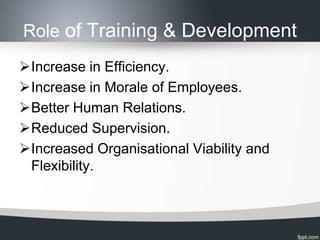Training and development slides (2)
- 1. Training & Development Arjun G. M120016MS
- 2. To Understand The concept of training and development and their role in developing individual competencies. Various methods of training and development and their suitability. The nature of organisation development and its role in organisational effectiveness. The nature and methods of self development.
- 3. Concept of Training and Development Training The act of increasing the skills of an employee for doing a particular job, and thus it’s a process of learning a sequence of programmed behaviour to do that particular job. Development It refers broadly to the nature and direction of change induced in employees, through the process of training and educative process.
- 4. Training & Development : A Comparison Training short term for a definite purpose. Development long term educational for general purpose.
- 5. Role of Training & Development Increase in Efficiency. Increase in Morale of Employees. Better Human Relations. Reduced Supervision. Increased Organisational Viability and Flexibility.
- 6. Identifying Training Needs Basic aim of Training • Suitable change in the individual concerned. • Should be related both in terms of organisation’s demand and that of individual’s. Various Methods for identifying Training Needs • Organisational Analysis. • Task Analysis. • Man Analysis.
- 7. Training Methods • On the job Training (OJT) • Demonstration • Job Instruction Training • Vestibule Training • Apprenticeship • Coaching/Understudy • Job Rotation • Simulation Training • Sensitivity Training Continue
- 8. On the job Training (OJT) • To learn by doing itself – Basic Theme • Learns the method involved and gets perfection over a specific task. • On experience, job performance will be high and become more efficient. Continue
- 9. Demonstration • Describes and displays • More effective – mechanical operations • Combined with lectures and group discussions Continue
- 10. Job Instruction Training (JIT) • ‘Training through step-by-step’ • Sequential arrangement of all steps. • What, how & when to be done • Providing job information-Positioning the trainees-try out work performance- encouraging to ask questions. Continue
- 11. Vestibule Training • Learn and develop skills in the similar situations. • 2 parts • Lecture method and practical exercise (workshops) • More freedom for experimentation. continue
- 12. Apprenticeship • Oldest and the most commonly used method • More time spent on productive job • Programme of assignments according to pre-determined schedule • Employees – Paid continue
- 13. Coaching / Understudy Coaching Direct personal instructions and guidance Continuous evaluation and correction Quick feedback Understudy Assist and will be supervised. To develop family members/ sponsored candidates continue
- 14. Job Rotation • One job to another • Broader view on system frame of reference • Cooperative approach to different functions • Confusion and affects performance continue
- 15. Simulation Training • Duplication of orginisational situations in a learning environment • A single brief session • Adapt to the situation and perceptions of various roles • Trainees participation is full • Will be provided with feedbacks and self evaluation by themselves continued
- 16. Sensitivity Training continue
- 17. Transactional Analysis • Social interaction b/w people- transaction • Ego states should be studied Parent Ego Adult Ego Child Ego

















